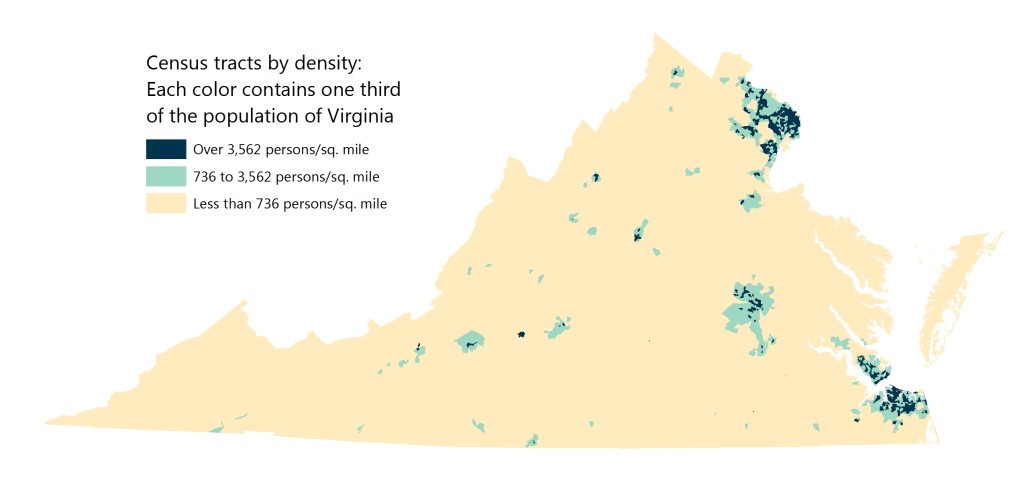Written by Dr. Rebecca Tippett and originally published at Carolina Demography. Over the next few weeks the First Furrow will be highlighting some of Rebecca’s excellent insights into rural North Carolina.
As we’ve mentioned in the past, North Carolina has a large population residing in areas that the U.S. Census Bureau classifies as rural. Among the 10 most populous states, North Carolina has the largest proportion of individuals living in rural areas. In fact, North Carolina’s rural population is larger than that of any other state except for Texas.
Prior to coming to Carolina Demography, I worked in a similar role producing and interpreting demographic data in Virginia. Since returning to North Carolina, I have mentioned to a number of people that North Carolina is more “demographically interesting” in certain respects than Virginia. This isn’t to say that Virginia isn’t interesting –it is!—but the fundamental patterns of demographics are markedly different in Virginia compared to North Carolina. And some of this difference is rooted in the higher proportion of individuals living in high density, urbanized areas in Virginia.
This difference was highlighted to me in a recent post by Luke Juday of UVa’s Demographics Research Group. In it, he discussed the “Three Virginias” according to population density (persons per square mile). Sorting the census tracts from most to least dense, he identified the “densest third,” the “middle third,” and the “sparsest third.” Each grouping contained a third of the state’s population. The resulting map highlights the concentration of Virginia’s population in what is commonly referred to as the urban crescent of Northern Virginia, Richmond, and Virginia Beach/Norfolk.
Out of curiosity, I replicated his effort in North Carolina. Although population is concentrated in the urban corridor that stretches from Charlotte to the Triad and the Triangle, it is significantly less concentrated than in the Virginia map. In comparison to the three metropolitan areas that dominate Virginia’s map, Asheville, Hickory, Fayetteville, Greenville, and Wilmington are all highly visible in the North Carolina map.
More telling, however, are the cutoff points. In Virginia, tracts in the densest third have 3,564 or more persons per square mile. This is more than twice the cutoff for North Carolina’s densest third: 1,400 persons per square mile.
If we use the top density threshold from Virginia in North Carolina and look only at North Carolina census tracts with 3,564 or more persons per square mile, these tracts contained only 732,680 residents in the 2010-14 American Community Survey, or 7.5% of the state’s 9.75 million population. This is far from the third of Virginia residents (~2.8 million) captured in such high density tracts in Virginia.
Similar differences are seen in the cutoff for the sparsest third. In Virginia, the sparsest census tracts have 736 or fewer persons per square mile. In North Carolina, the sparsest tracts have 276 or fewer persons per square mile.
These differences mean that Virginia’s population is much more heavily concentrated than North Carolina’s. Juday notes that the third of Virginia’s population living in the “densest third” occupy only about 1.2% of the state’s land mass, the “middle third” live on about 4%, and the remaining 94.8% of land is occupied by individuals in the “sparsest third.” In North Carolina, the densest third occupy 2.7% of the state’s land, the “middle third” live on 11.8% of the land, and the “sparsest third” on the remaining 85.5%.
North Carolina’s population is increasingly concentrated in urban areas. In 2010, two of every three North Carolinians lived in an urban area according to the U.S. Census Bureau, a major change for a state that was majority rural until 1990. Although this has been a significant change for the state, with implications for everything from transit planning to politics, North Carolina’s densest urban areas remain significantly less dense than many other states.
Rebecca Tippett, Ph.D, is the Director of Carolina Demography at the Carolina Population Center at UNC-Chapel Hill where she translates demographic and economic data into specific, usable information and knowledge to inform decision-making, evaluation, and policy. Her work has included forecasting population trends to determine the demand for new schools, identifying target locations for new businesses, evaluating population estimation methods for the U.S. Census Bureau, and examining demographic and labor market factors associated with employee turnover. She regularly writes and presents about the impact of demographic and social trends in North Carolina.
Carolina Demography is a demographic consulting service at the Carolina Population Center at UNC-Chapel Hill. They provide a full array of demographic data and research services for North Carolina businesses, foundations, government agencies, schools, not-for-profit organizations, and many more. Contact them today to setup a free initial consultation.


